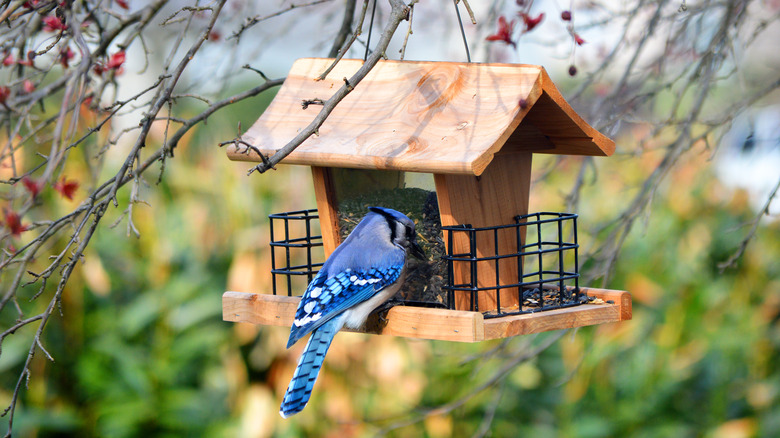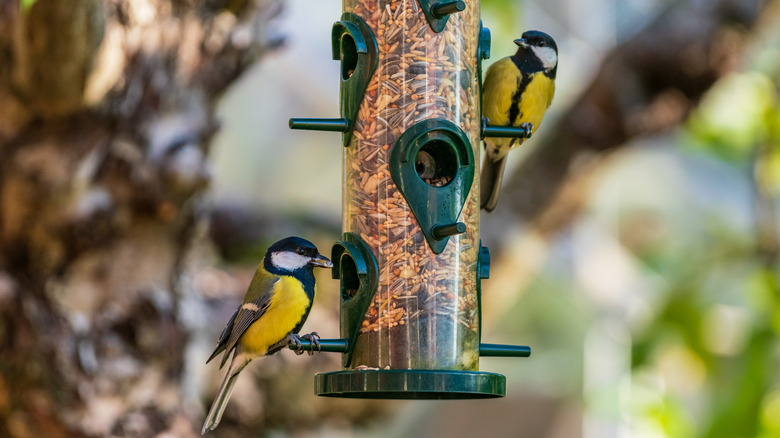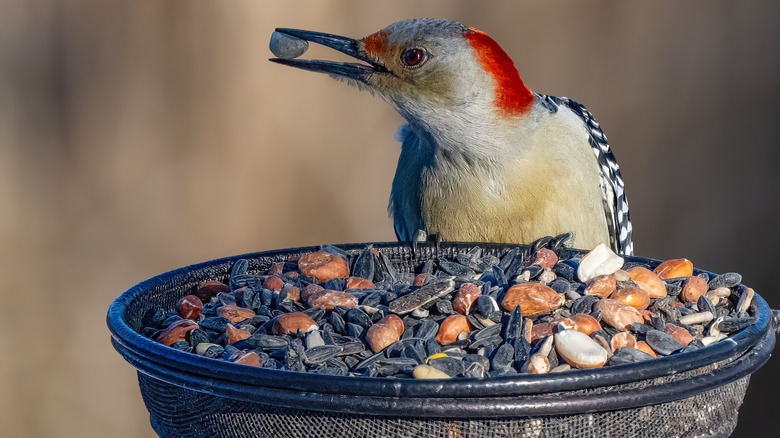What You Should Be Looking For In A Bird Feeder, According To Conservationists
We may receive a commission on purchases made from links.
Picking out the right bird feeder makes all the difference when it comes to attracting feathered friends to your yard. There are countless ways to make a DIY bird feeder if you're on a budget, from covering paper rolls with suet concoctions to upcycling milk cartons or used plastic bottles. But whether you're going to build your own bird feeder or invest in one from a big box or gardener's supply store, there are certain features and qualities you should consider. House Digest spoke exclusively to Charles van Rees, Ph.D., a conservation scientist, naturalist, and owner of the Gulo in Nature, about which are most important. According to van Rees, you should base your decision on the bird species you want to attract and where you intend to install your new feeder, choosing ones made of sustainable materials that are easy to clean and won't biodegrade.
Van Rees said there are four important factors he thinks about when helping people pick feeders: the material, overall design, ability to clean, and ease of installation. "Birds are generally very intelligent, and they are bound to find, recognize, and feed from a bird feeder if they come across it," he explained. Although your avian guests may not be bothered, the conservationist recommended avoiding feeders made from plastic. "Plastic breaks down and introduces microplastics into the environment," he cautioned, adding that rodents can also easily chew through them. Instead, van Rees strongly advocated for feeders made from wood or metal.
Determine what kind of birds you want and how much maintenance you're willing to do
"The best design of bird feeder will depend on the species that a person wants to attract, and what species they might want to exclude," Charles van Rees said during his exclusive interview with House Digest. "If you don't particularly care which birds are feeding on seeds, platform feeders are a great way to just make food available and see who shows up," he added. Popular platform feeders like the Wild Wings Cedar Tray from Amazon are an ideal way to keep squirrels off your bird feeder because they are weight sensitive. "Platform feeders also allow you to put out any old kind of food, for example peanuts or orange slices in addition to just piles of birdseed," van Rees said. When you only want to attract certain species to your yard, the conservationist said a hopper feeder is a better choice — you can use them to prevent birds with certain weights or beak sizes from accessing the seeds. "Some work better with certain kinds of seeds than others, so there may be a little more research involved," he clarified.
Van Rees said you also need to choose a bird feeder that's easy to install and maintain. "Feeders with a lot of different components can be very difficult," he cautioned. "Responsible homeowners will frequently clean feeders to keep them free of mold and prevent the transmission of disease between birds ... The easier you make this on yourself, the better!" The conservationist highly recommended bird feeders that can be moved around as needed throughout the year.
Consider your geographic location and available space
According to Charles van Rees, the area surrounding your bird feeder is just as important as the feeder itself. "Homeowners should consider their geographic location," he told House Digest during his exclusive interview. "What types of birds are likely to occur there? What time of year are they hoping to attract birds, and what species, of those that are likely to show up, [do] they want to see?" By answering these questions, you'll be able to more carefully tailor not just the type of bird feeder that's best for your location but also the type of seed you'll use to fill it. No matter where you live, installing bird feeders is just one way birdscaping can turn your yard and garden into a bird haven.
The naturalist also said you'll need to consider your available space for a feeder and determine whether you can mount them on trees or if you'll need to install a pole. "Different bird species have different degrees of curiosity and interest in poking around with feeders, as well as different bill types and body shapes that influence how easily they can access seeds, and whether they can perch on or near feeders to get at the available food," he explained. That's one reason van Rees prefers platform feeders. "Even larger, clumsier birds like orioles and grackles or large woodpeckers can access them easily, and seeing larger birds can be a lot of fun," he said. However, he cautioned that a platform feeder can quickly turn into a feeding free-for-all, attracting not just birds but squirrels and other hungry wildlife, so you'll need to fill it more frequently.


